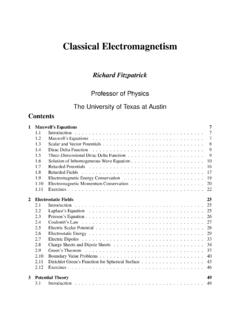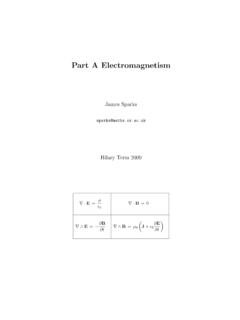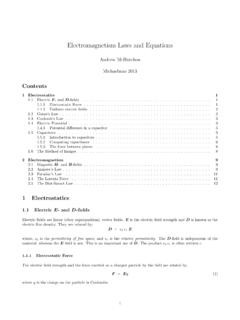Transcription of Classical Electromagnetic Theory Second Edition
1 Classical Electromagnetic TheorySecond EditionFundamental Theories of PhysicsAn International Book Series on The Fundamental Theories of Physics:Their Clarification, Development and ApplicationEditor:ALWYN VAN DER MERWE, University of Denver, Advisory Board:GIANCARLO GHIRARDI, University of Trieste, ItalyLAWRENCE P. HORWITZ, Tel-Aviv University, IsraelBRIAN D. JOSEPHSON, University of Cambridge, KILMISTER, University of London, J. LAHTI, University of Turku, FinlandASHER PERES, Israel Institute of Technology, IsraelEDUARD PRUGOVECKI, University of Toronto, CanadaFRANCO SELLERI, Universit di Bara, ItalyTONY SUDBERY, University of York, RGEN TREDER, Zentralinstitut f r Astrophysik der Akademie derWissenschaften, GermanyVolume 145 ClassicalElectromagnetic TheorySecond EditionbyJack VanderlindeUniversity of New Brunswick,Fredericton, NB, CanadaKLUWER ACADEMIC PUBLISHERSNEW YORK, BOSTON, DORDRECHT, LONDON, MOSCOWeBook ISBN:1-4020-2700-1 Print ISBN.
2 1-4020-2699-4 2005 Springer Science + Business Media, 2004 Kluwer Academic PublishersAll rights reservedNo part of this eBook may be reproduced or transmitted in any form or by any means, electronic,mechanical, recording, or otherwise, without written consent from the PublisherCreated in the United States of AmericaVisit Springer's eBookstore at: the Springer Global Website Online at: questions of science, the authority of a thousand is notworth the humble reasoning of a single Galilei, physicist and astronomer (1564-1642)This book is a Second Edition of Classical Electromagnetic Theory which derivedfrom a set of lecture notes compiled over a number of years of teaching electro-magnetic Theory to fourth year physics and electrical engineering students.
3 Thesestudents had a previous exposure to electricity and magnetism, and the materialfrom the first four and a half chapters was presented as a review. I believe that thebook makes a reasonable transition between the many excellent elementary bookssuch as Griffith sIntroduction to Electrodynamicsand the obviously graduate levelbooks such as Jackson sClassical Electrodynamicsor Landau and Lifshitz Electro-dynamics of Continuous Media. If the students have had a previous exposure toElectromagnetic Theory , all the material can be reasonably covered in two should probable spend a semester on the first four or five chapters aswell as, depending on their mathematical background, the Appendices B to F.
4 Fora shorter or more elementary course, the material on sphericalwaves, waveguides,and waves in anisotropic media may be omitted without loss of this Edition I have added a segment on Schwarz-Christoffel transformations tomore fully explore conformal mappings. There is also a short heuristic segment onCherenkov radiation and Bremstrahlung. In Appendix D there is a brief discussionof orthogonal function expansions. For greater completeness, Appendices E and Fhave been expanded to include the solution of the Bessel equation and Legendre sequation as well as obtaining the generating function of each of the solutions.
5 Thismaterial is not intended to supplant a course in mathematical methods but toprovide a ready reference provide a backstop for those topics missed used vector identities and other useful formulas are found on the insideof the back cover and referred to inside the text by simple number (1) to (42).Addressing the complaint I don t know where to start, although I understand allthe Theory , from students faced with a non-transparent problem, I have includeda large number of examples of varying difficulty, worked out in detail. This editionhas been enriched with a number of new examples. These examples illustrate boththe Theory and the techniques used in solving problems.
6 Working through theseexamples should equip the student with both the confidence and the knowledgeto solve realistic problems. In response to suggestions by my colleagues I havenumbered all equations for ease of referencing and more clearly delineated examplesfrom the main students appear generally much less at ease with magnetic effects than v viClassical Electromagnetic Theorywith electrical phenomena, the theories of electricity and magnetism are developedin parallel. From the demonstration of the underlying interconvertability of thefields in Chapter One to the evenhanded treatment of electrostatic and magneto-static problems to the covariant formulation, the treatment emphasizes the relationbetween the electric and magnetic fields.
7 No attempt has been made to follow thehistorical development of the extensive chapter on the solution of Laplace s equation explores most of thetechniques used in electro- and magnetostatics, including conformal mappings andseparation of variable in Cartesian, cylindrical polar, spherical polar and oblate el-lipsoidal coordinates. The magnetic scalar potential is exploited in many examplesto demonstrate the equivalence of methods used for the electric and magnetic po-tentials. The next chapter explores the use of image charges in solving Poisson sequation and then introduces Green s functions, first heuristically, then more for-mally.
8 As always, concepts introduced are put to use in examples and exercises. Afairly extensive treatment of radiation is given in the later portions of this implications of radiation reaction on causality and other limitations of thetheory are discussed in the final have chosen to sidestep much of the tedious vector algebra and vector cal-culus by using the much more efficient tensor methods, although, on the adviceof colleagues, delaying their first use to chapter 4 in this Edition . Although it al-most universally assumed that students have some appreciation of the concept ofa tensor, in my experience this is rarely the case.
9 Appendix B addresses this fre-quent gap with an exposition of the rudiments of tensor analysis. Although thisappendix cannot replace a course in differential geometry, I strongly recommend itfor self-study or formal teaching if students are not at ease with tensors. The lattersegments of this appendix are particularly recommended as an introduction to thetensor formulation of Special exercises at the end of each chapter are of varying difficulty but all shouldbe within the ability of strong senior students. In some problems, concepts notelaborated in the text are explored. A number of new problems have been added tothe text both as exercises and as examples.
10 As every teacher knows, it is essentialthat students consolidate their learning by solving problems on a regular basis. Atypical regimen would consist of three to five problems have attempted to present clearly and concisely the reasoning leading to in-ferences and conclusions without excessive rigor that would make this a book inMathematics rather than Physics. Pathological cases are generally dismissed. In anattempt to have the material transfer more easily to notes or board, I have labelledvectors by overhead arrows rather than the more usual bold face. As the materialdraws fairly heavily on mathematics I have strived to make the book fairly selfsufficient by including much of the relevant material in SI units are employed throughout this book, having the advantageof yielding the familiar electrical units used in everyday life.













